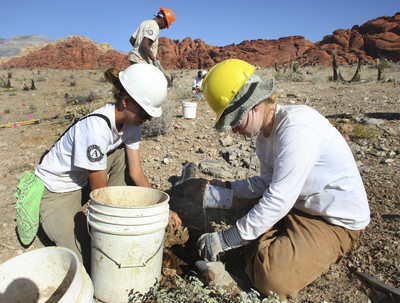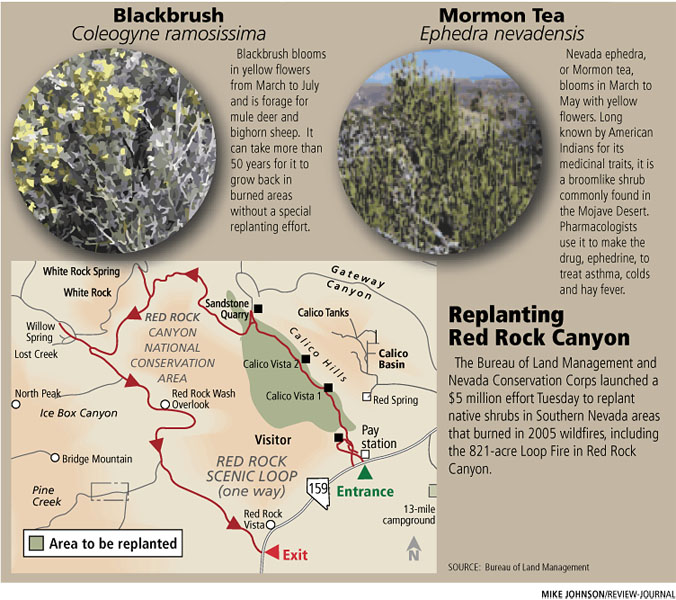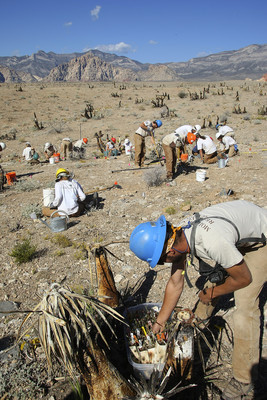Desert islands of growth
The sound of picks and shovels pounding the hard Mojave Desert soil signaled the return of plant life Tuesday to the core of Red Rock Canyon's scenic loop.
It was the first day for a team of Nevada Conservation Corps workers to replant native shrubs in an 821-acre swath that burned two years ago in a wildfire caused by a lightning strike.
It marked the initial strike by public lands managers of a $5 million effort to put blackbrush and Nevada ephedra, or Mormon Tea, back on the road to recovery there and in three other burned areas in Southern Nevada including those scorched by wildfires at Gold Butte near Mesquite, 75 miles northeast of Las Vegas.
"We're trying to put islands of growth in the burn area. Then its seeds will spread. That's our hope," said Adam Stoldal, a Las Vegas rock climber and supervisor for the team of largely college-age students from across the country who are camping out and being paid stipends to complete the task.
Although the pay is not much, "It's very rewarding," said Megan Sheehan, from the University of Cincinnati. "You feel good mentally and physically. It's a double payoff," she said while helping Illinois Wesleyan graduate Jeanette Otis nudge a blackbrush sprout into its new home.
The Loop Fire for a while closed Red Rock Canyon's 13-mile road, turning a vibrant desert setting in the heart of the national conservation area into a blackened moonscape appearance in July 2005. Only charred Yucca stumps were left jutting from the barren surface.
Bureau of Land Management botanist Christina Lund, who orchestrated the rehabilitation effort, carried a pair of tin watering cans to where a plot of 50 shrubs, each covered by protective screens, had been planted.
"Everything is getting a gallon of water when they go in the ground," she explained about the project, which is as much a Mojave Desert ecology experiment as it is a restoration effort.
About one-fourth of the plants will grow in soil laced with Zeba, a polymer that keeps moisture in the ground.
Most of the other plants won't get any water but some are being planted with a refillable, water-bottle device that will help nurture them through dry spells.
"We don't want to be out here watering every week," Lund said.
Blackbrush and ephedra seeds were collected from within 100 miles of the planting areas and then grown into plants by the Nevada Division of Forestry and the College of Southern Nevada. Last year, some seeds were dropped by aircraft over burn areas to enhance whatever takes hold in the replanting effort.
"We're doing an evaluation on it so we can see how restoration will work in the future at other places in the Mojave," said BLM spokeswoman Kirsten Cannon.
She said botanists can't predict yet what the survival rate will be but they hope control plants that won't be watered or given special treatment will give them a better handle on what percentage will take hold in the wild and how the odds of surviving can be increased by the other methods under way.
Cannon said Nevada ephedra was selected because it is one of the most common desert shrubs and reproduces well from seeds. Pharmacologists also use it to produce the drug, ephedrine, used in medications for colds, asthma and allergies. Ephedrine is also an ingredient used in the illegal production of methamphetamine but Cannon noted that the BLM hasn't had a problem with illegal collection of ephedra from public lands.
"It's in the Mojave everywhere," she said.
"If people eat it or drink it without proper knowledge of its effects, they can become sick from its poisons," she said.
Blackbrush typically returns to burn areas slowly, taking at times up to 50 years to re-establish.
In all, 4,800 shrubs will be replanted in about 100 different plots in the burned areas of the Loop and Goodsprings wildfires as well as the Tramp and Fork wildfires near Gold Butte.
About 250,000 acres of public lands burned in Southern Nevada during the 2005 wildfires. Invasive plants, such as non-native red brome and other noxious weeds provided flash fuels that made the fires worse than they would have been if only native shrubs dominated the landscape.
The goal of the rehabilitation effort is to restore native plants and prevent invasive species from taking over, said BLM Fire Management Officer Kevin Oliver.
Lund said areas chosen for replanting were prioritized. Red Rock Canyon was given a high priority because it is a national conservation area. Critical habitat areas for desert tortoises and other species also ranked high for replanting.
More than 1 million acres of desert tortoise habitat burned in 2005 in the Mojave Desert region that spans southern parts of Nevada, Utah, California and Northern Arizona. That included 32,000 acres just in Nevada of critical habitat for the desert tortoise.
Contact reporter Keith Rogers at krogers@reviewjournal.com or (702) 383-0308.



















